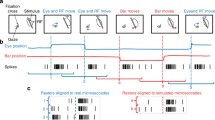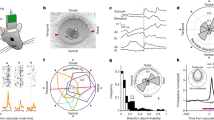Summary
The stability of visual perception despite eye movements suggests the existence, in the visual system, of neural elements able to recognize whether a movement of an image occurring in a particular part of the retina is the consequence of an actual movement that occurred in the visual field, or self-induced by an ocular movement while the object was still in the field of view. Recordings from single neurons in area V3A of awake macaque monkeys were made to check the existence of such a type of neurons (called ‘real-motion’ cells; see Galletti et al. 1984, 1988) in this prestriate area of the visual cortex. A total of 119 neurons were recorded from area V3A. They were highly sensitive to the orientation of the visual stimuli, being on average more sensitive than V1 and V2 neurons. Almost all of them were sensitive to a large range of velocities of stimulus movement and about one half to the direction of it. In order to assess whether they gave different responses to the movement of a stimulus and to that of its retinal image alone (self-induced by an eye movement while the stimulus was still), a comparison was made between neuronal responses obtained when a moving stimulus swept a stationary receptive field (during steady fixation) and when a moving receptive field swept a stationary stimulus (during tracking eye movement). The receptive field stimulation at retinal level was physically the same in both cases, but only in the first was there actual movement of the visual stimulus. Control trials, where the monkeys performed tracking eye movements without any intentional receptive field stimulation, were also carried out. For a number of neurons, the test was repeated in darkness and against a textured visual background. Eighty-seven neurons were fully studied to assess whether they were real-motion cells. About 48% of them (42/87) showed significant differences between responses to stimulus versus eye movement. The great majority of these cells (36/42) were real-motion cells, in that they showed a weaker response to visual stimulation during tracking than to the actual stimulus movement during steady fixation. On average, the reduction in visual response during eye movement was 64.0 ± 15.7% (SD). Data obtained with a uniform visual background, together with those obtained in darkness and with textured background, indicate that real-motion cells receive an eye-motion input, either retinal or extraretinal in nature, probably acting presynaptically on the cell's visual input. In some cases, both retinal and extraretinal eye-motion inputs converge on the same real-motion cell. No correlation was observed between the real-motion behaviour and the sensitivity to either orientation or direction of movement of the visual stimulus used to activate the receptive field, nor with the retinotopic location of the receptive field. We suggest that the visual system uses real-motion cells in order to distinguish real from self-induced movements of retinal images, hence to recognize the actual movement in the visual field. Based on psychophysical data, the hypothesis has been advanced of an internal representation of the field of view, stable despite eye movement (cf. MacKay 1973). The real-motion cells may be neural elements of this network and we suggest that the visual system uses the output of this network to properly interpret the large number of sensory changes resulting from exploratory eye movements in a stable visual world.
Similar content being viewed by others
References
Aicardi G, Battaglini PP, Galletti C (1987) Retinal eye-motion input affects real-motion cell activity in the V3-complex of behaving macaque monkeys. J Physiol (Lond) 388:47P
Allman J, Miezin F, McGuinness E (1985) Stimulus specific responses from beyond the classical receptive field: neurophysiological mechanisms for local-global comparisons in visual neurons. Ann Rev Neurosci 8: 407–430
Andersen RA, Essick GK, Siegel RM (1985) Encoding of spatial location by posterior parietal neurons. Science 230: 456–458
Battaglini PP, Squatrito S, Morandi C, Galletti C (1984) Microprocessor based system for spike and eye-movement acquisition and storage. Pflügers Arch Ges Physiol 400: 194–196
Bizzi E (1968) Discharge of frontal eye field neurons during saccadic and following eye movements in unanesthetized monkeys. Exp Brain Res 6: 69–80
Brindley GS, Goodwin GM, Kulikowski JJ, Leighton D (1976) Stability of vision with a paralysed eye. J Physiol (Lond) 258: 65P-66P
Brindley GS, Lewin WS (1968) The sensations produced by electrical stimulation of the visual cortex. J Physiol (Lond) 196: 479–493
Brindley GS, Merton PA (1960) The absence of position sense in the human eye. J Physiol (Lond) 153: 127–130
Fischer B, Krüger J (1974) The shift-effect in cat's lateral geniculate neurones. Exp Brain Res 21: 225–277
Galletti C, Battaglini PP (1989) Gaze-dependent visual neurons in area V3A of monkey prestriate cortex. J Neurosci 9: 1112–1125
Galletti C, Battaglini PP, Aicardi G (1988) ‘Real-motion’ cells in visual area V2 of behaving macaque monkeys. Exp Brain Res 69: 279–288
Galletti C, Squatrito S, Battaglini PP, Maioli MG (1984) ‘Realmotion’ cells in the primary visual cortex of macaque monkeys. Brain Res 301: 95–110
Grüsser OJ, Grüsser-Cornehls U (1973) Neuronal mechanisms of visual movement perception and some psychophysical and behavioral correlations. In: Jung R (ed) Handbook of sensory physiology, Vol VII/3A. Springer, Berlin Heidelberg New York, pp 333–429
Hammond P, Merton PA, Sutton GG (1956) Nervous gradation of muscular contraction. Br Med Bull 12: 214–218
Helmholtz von H (1909) Handbuch der physiologischen Optik. Voss, Hamburg, 3rd edn. English translation by Southall JPC (1924) for the Optical Society of America
Hughlings Jackson J (1932) Selected writings, Vol 2. Hodder and Stoughton, London
Judge SJ, Richmond BJ, Chu FC (1980) Implantation of magnetic search coils for measurement of eye positions: an improved method. Vision Res 20: 535–538
Kaufman L (1974) Sight and mind. Oxford University Press, New York
Kling JW, Riggs LA (1971) Experimental psychology. Holt, Rinehart and Winston, New York
Komatsu H, Wurtz RH (1988) Relation of cortical areas MT and MST to pursuit eye movements. I. Localization and visual properties of neurons. J Neurophysiol 60: 580–603
Kornmüller AE (1931) Eine experimentelle Anasthesie der äußeren Augenmuskeln von Menschen und ihre Auswirkungen. J Psychol Neurol 41: 354–366
Krüger J, Fischer B (1973) Strong periphery effect in cat retinal ganglion cells: excitatory responses in ON- and OFF-center neurones to single grid displacements. Exp Brain Res 18: 316–318
Lynch JC, Mountcastle VB, Talbot WH (1977) Parietal lobe mechanisms for directed visual attention. J Neurophysiol 40: 362–389
Mach E (1886) Beiträge zur Analyse der Empfindungen. Fischer, Jena. English translation (1959): The analysis of sensations. Dover, New York
Mack A (1970) An investigation of the relationship between eye and retinal image movement in the perception of movement. Percept Psychophys 8: 291–297
Mack A, Bachant J (1969) Perceived movement of the after image during eye movements. Percept Psychophys 6: 379–384
MacKay DM (1973) Visual stability and voluntary eye movements. In: Jung R (ed) Handbook of sensory physiology, Vol VII/3A. Springer, Berlin Heidelberg New York, pp 307–332
Maunsell JHR, Newsome WT (1987) Visual processing in monkey extrastriate cortex. Ann Rev Neurosci 10: 363–401
Mustari MJ, Fuchs AF, Langer TP, Kaneko C, Wallman J (1988) The role of the primate lateral terminal nucleus in visuomotor behavior. In: Hicks TP, Benedeck G (eds) Vision within extrageniculo-striate system. Prog Brain Res. 75: 121–128
Noda H, Suzuki DA (1979) The role of the flocculus of the monkey in fixation and smooth pursuit eye movements. J Physiol 294: 335–348
Robinson DA (1963) A method of measuring eye movement using a scleral search coil in a magnetic field. IEEE Trans Biomed Eng 10: 137–145
Robinson DL, Petersen SE (1985) Responses of pulvinar neurons to real and self-induced stimulus movement. Brain Res 338: 392–394
Robinson DL, Wurtz RH (1976) Use of an extraretinal signal by monkey superior colliculus neurons to distinguish real from self-induced stimulus movement. J Neurophysiol 39: 852–870
Sakata H, Shibutani H, Kawano K, Harrington TL (1985) Neural mechanisms of space vision in the parietal association cortex of the monkey. Vision Res 25: 453–463
Schlag-Rey M, Schlag J (1984) Visuomotor functions of central thalamus in monkey. I. Unit activity related to spontaneous eye movements. J Neurophysiol 51: 1149–1174
Siebeck R (1954) Wahrnehmungsstörung und Störungswahrnehmung bei Augenmuskellähmungen. Albrecht von Graefes Arch Ophthalmol 155: 26–34
Stevens JK, Emerson RC, Gerstein RL, Kallos T, Neufeld GR, Nichols CW, Rosenquist AC (1976) Paralysis of the awake human: visual perceptions. Vision Res 16: 93–98
Suzuki H, Azuma M (1976) A glass-insulated ‘elgiloy’ microelectrode for recording unit activity in chronic monkey experiments. Electroenceph Clin Neurophysiol 41: 93–95
Suzuki DA, Noda H, Kase M (1981) Visual and pursuit eye movement-related activity in posterior vermis of monkey cerebellum. J Neurophysiol 46: 1120–1139
Tanaka K, Hikosaka K, Saito H, Yukie M, Fukada Y, Iwai E (1986) Analysis of local and wide-field movements in the superior temporal visual areas of the macaque monkey. J Neurosci 6: 134–144
Thier P, Koehler W, Buettner UW (1988) Neuronal activity in the dorsolateral pontine nucleus of the alert monkey modulated by visual stimuli and eye movements. Exp Brain Res 70: 496–512
Van Essen DC, Zeki SM (1978) The topographic organization of rhesus monkey prestriate cortex. J Physiol (Lond) 277: 193–226
Wallace H (1985) Perceiving a stable environment. Sci Am 252: 92–98
Wipple WR, Wallach H (1978) Direction-specific motion threshold for abnormal image shifts during saccadic eye movement. Percept Psychophys 24: 349–355
Yarbus AL (1967) Eye movements and vision. Plenum Press, New York
Zeki S, Shipp S (1988) The functional logic of cortical connections. Nature 335: 311–317
Author information
Authors and Affiliations
Rights and permissions
About this article
Cite this article
Galletti, C., Battaglini, P.P. & Fattori, P. ‘Real-motion’ cells in area V3A of macaque visual cortex. Exp Brain Res 82, 67–76 (1990). https://doi.org/10.1007/BF00230838
Received:
Accepted:
Issue Date:
DOI: https://doi.org/10.1007/BF00230838




